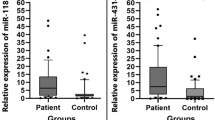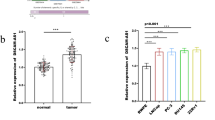Abstract
MicroRNA-335 (miR-335) acts as a tumor suppressor or a tumor promoter in different human malignancies. However, the involvement of miR-335 in prostate cancer (PCa) is still unclear. The purpose of this study was to investigate the functional and clinical significance of miR-335 in PCa. miR-335 expression in 3 PCa cell lines (LNCaP/DU145/PC3) and in 20 clinical PCa tissues were detected by real-time quantitative reverse transcriptase-PCR compared with corresponding controls. The function of miR-335 was investigated for cell proliferation, invasion and migration in PCa cells transfected with agents containing EGFP-miR-335 expression vector. Additionally, miR-335 expression in 104 clinical PCa tissues was detected by in situ hybridization. Its assocaitions with clinicopathological features and prognosis in patients with PCa were also determined. miR-335 was significantly down-regulated in PCa cell lines than in the normal prostate cell line (P < 0.01). With the similar results in vitro, the reduced expression of miR-335 was also found in human PCa tissues comparing with paired adjacent benign prostate tissues (P < 0.05). Moreover, the increased expression of miR-335 suppressed cell proliferation, invasion and migration of PCa cell lines in vitro. Turning to its clinical significance, the low expression of miR-335 was significantly associated with high Gleason Score (P = 0.04), advanced clinical stage (P = 0.04), and positive metastasis (P = 0.02), but not with prognosis in PCa patients. Our data demonstrated for the first time the inhibitory effect of miR-335 on cell proliferation and invasion for PCa cells. The loss of this microRNA might be associated with clinical progression of PCa patients.






Similar content being viewed by others
References
Siegel R, Naishadham D, Jemal A (2012) Cancer statistics, 2012. CA Cancer J Clin 62:10–29
Utomo NB, Mochtar CA, Umbas R (2012) Primary hormonal treatment in localized and locally advanced prostate cancer: effectiveness and survival predictive factors. Acta Med Indones 44:10–15
Dasgupta S, Srinidhi S, Vishwanatha JK (2012) Oncogenic activation in prostate cancer progression and metastasis: molecular insights and future challenges. J Carcinog 11:4
Bartel DP (2004) MicroRNAs: genomics, biogenesis, mechanism, and function. Cell 116:281–297
Calin GA, Liu CG, Sevignani C, Ferracin M, Felli N, Dumitru CD, Shimizu M, Cimmino A, Zupo S, Dono M, Dell’Aquila ML, Alder H, Rassenti L, Kipps TJ, Bullrich F, Negrini M, Croce CM (2004) MicroRNA profiling reveals distinct signatures in B cell chronic lymphocytic leukemias. Proc Natl Acad Sci USA 101:11755–11760
Porkka KP, Pfeiffer MJ, Waltering KK, Vessella RL, Tammela TL, Visakorpi T (2007) MicroRNA expression profiling in prostate cancer. Cancer Res 67:6130–6135
Shu M, Zhou Y, Zhu W, Zhang H, Wu S, Chen J, Yan G (2012) MicroRNA 335 is required for differentiation of malignant glioma cells induced by activation of cAMP/protein kinase A pathway. Mol Pharmacol 81:292–298
Nakanishi N, Nakagawa Y, Tokushige N, Aoki N, Matsuzaka T, Ishii K, Yahagi N, Kobayashi K, Yatoh S, Takahashi A, Suzuki H, Urayama O, Yamada N, Shimano H (2009) The up-regulation of microRNA-335 is associated with lipid metabolism in liver and white adipose tissue of genetically obese mice. Biochem Biophys Res Commun 385:492–496
Tavazoie SF, Alarcón C, Oskarsson T, Padua D, Wang Q, Bos PD, Gerald WL, Massagué J (2008) Endogenous human microRNAs that suppress breast cancer metastasis. Nature 451:147–152
Wang F, Zheng Z, Guo J, Ding X (2010) Correlation and quantitation of microRNA aberrant expression in tissues and sera from patients with breast tumor. Gynecol Oncol 119:586–593
Sorrentino A, Liu CG, Addario A, Peschle C, Scambia G, Ferlini C (2008) Role of microRNAs in drug-resistant ovarian cancer cells. Gynecol Oncol 111:478–486
Shu M, Zheng X, Wu S, Lu H, Leng T, Zhu W, Zhou Y, Ou Y, Lin X, Lin Y, Xu D, Zhou Y, Yan G (2011) Targeting oncogenic miR-335 inhibits growth and invasion of malignant astrocytoma cells. Mol Cancer 10:59
Chen JH, He HC, Jiang FN et al (2012) Analysis of the specific pathways and networks of prostate cancer for gene expression profiles in the Chinese population. Med Oncol 29:1972–1984
Chen C, Ridzon DA, Broomer AJ et al (2005) Real-time quantification of microRNAs by stem-loop RT-PCR. Nucleic Acids Res 33:e179
Nuovo GJ (2008) In situ detection of precursor and mature microRNAs in paraffin embedded, formalin fixed tissues and cell preparations. Methods 44:39–46
Wang L, Alcon A, Yuan H, Ho J, Li QJ, Martins-Green M (2011) Cellular and molecular mechanisms of pomegranate juice-induced anti-metastatic effect on prostate cancer cells. Integr Biol 3:742–754
Vickers MM, Bar J, Gorn-Hondermann I, Yarom N, Daneshmand M, Hanson JE, Addison CL, Asmis TR, Jonker DJ, Maroun J, Lorimer IA, Goss GD, Dimitroulakos J (2012) Stage-dependent differential expression of microRNAs in colorectal cancer: potential role as markers of metastatic disease. Clin Exp Metastasis 29:123–132
Marcucci G, Maharry K, Radmacher MD, Mrόzek K, Vukosavljevic T, Paschka P (2008) Prognostic significance of, and gene and microRNA expression signatures associated with, CEBPA mutations in cytogenetically normal acute myeloid leukemia with highrisk molecular features: a Cancer and Leukemia Group B Study. J Clin Oncol 26:5078–5087
Soon PS, Tacon LJ, Gill AJ, Bambach CP, Sywak MS, Campbell PR (2009) miR-195 and miR-483-5p identified as predictors of poor prognosis in adrenocortical cancer. Clin Cancer Res 15:7684–7692
Xu Y, Zhao F, Wang Z, Song Y, Luo Y, Zhang X, Jiang L, Sun Z, Miao Z, Xu H (2012) MicroRNA-335 acts as a metastasis suppressor in gastric cancer by targeting Bcl-w and specificity protein 1. Oncogene 31:1398–1407
Wang YX, Zhang XY, Zhang BF, Yang CQ, Chen XM, Gao HJ (2010) Initial study of microRNA expression profiles of colonic cancer without lymph node metastasis. J Dig Dis 11:50–54
Zhang H, Luo XQ, Zhang P, Huang LB, Zheng YS, Wu J, Zhou H, Qu LH, Xu L, Chen YQ (2009) MicroRNA patterns associated with clinical prognostic parameters and CNS relapse prediction in pediatric acute leukemia. PLoS One 4:e7826
Ronchetti D, Lionetti M, Mosca L, Agnelli L, Andronache A, Fabris S, Deliliers GL, Neri A (2008) An integrative genomic approach reveals coordinated expression of intronic miR-335, miR-342, and miR-561 with deregulated host genes in multiple myeloma. BMC Med Genomics 1:37
Wang J, Ruan K (2010) miR-335 is involved in the rat epididymal development by targeting the mRNA of RASA1. Biochem Biophys Res Commun 402(2):222–227
Acknowledgements
This work was supported by grants from National Natural Science Foundation of China (81170699), Guangzhou Municipal Science and Technology Key Project (11C23150711), Key Projects of Bureau of Health in Guangzhou Municipality (201102A212015), Projects of Guangdong Key Laboratory of Urology (2010A060801016). Medical and Health Science and Technology Project in Guangzhou Municipality (20121A011024).
Competing Interests
The authors declare that they have no competing interests.
Author information
Authors and Affiliations
Corresponding authors
Additional information
Si-wei Xiong and Tian-xin Lin contributed equally to this article.
Rights and permissions
About this article
Cite this article
Xiong, Sw., Lin, Tx., Xu, Kw. et al. MicroRNA-335 Acts as a Candidate Tumor Suppressor in Prostate Cancer. Pathol. Oncol. Res. 19, 529–537 (2013). https://doi.org/10.1007/s12253-013-9613-5
Received:
Accepted:
Published:
Issue Date:
DOI: https://doi.org/10.1007/s12253-013-9613-5




